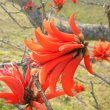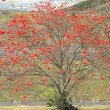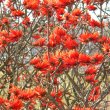Erythrina lysistemon
| Botanical Name | Erythrina lysistemon |
|||||||||||||||||||||
| Family | Fabaceae - The legume and pod-bearing family. (Pea & Bean Family) |
|||||||||||||||||||||
| Pronunciation | er-ith-RY-nuh lye-sis-STEM-on |
|||||||||||||||||||||
| Common Name(s) |
English: Common coral tree; Lucky bean tree
Afrikaans: Gewone koraalboom; Kanniedood
IsiXhosa: umsintsi; umkloka
IsiZulu: umsinsi
Sesotho: mokhungwane
Tshivenda: muvhale
Setswana: mophete
|
|||||||||||||||||||||
| Plant Group |
|
|||||||||||||||||||||
| Plant Size |
|
|||||||||||||||||||||
| Position |
|
|||||||||||||||||||||
| General Information |
|
|||||||||||||||||||||
| Specific Information | Conspicuous when in flower, this striking tree with its spreading crown, Erythrina lysistemon is widely grown for its year-long attraction and usefulness. The trunk is stocky and branches often split low down. The bark is greyish with short, hooked prickles randomly dispersed on the trunk and branches. Small pickles are also found on the leaves and petioles. Flowers often appear before or concurrently with the new leaves. The black pods split to reveal bright red seeds, often called 'lucky beans'. The tree provides food and shelter for a variety of birds, animals and insects. The flowers produce liberal amounts of nectar. It is useful in the garden for plants that require some sun in winter and shade in summer. The roots are aggressive and the tree should not be planted too close to permanent structures. The Zulu nation regarded Erythrina lysistemon as a royal tree, and they were planted on the graves of chiefs. |
|||||||||||||||||||||
| Ad Break | ||||||||||||||||||||||
| Flowers | ||||||||||||||||||||||
| Description | dense heads of narrow, outwardly curved, flowers hanging from long sturdy stalks |
|||||||||||||||||||||
| Season |
|
|||||||||||||||||||||
| Colour |
|
|||||||||||||||||||||
| Growth Rate |
|
|||||||||||||||||||||
| Plant Uses |
|
|||||||||||||||||||||
| Distribution and Habitat | ||||||||||||||||||||||
| Planting Suggestions | Erythrina lysistemon does best in fertile, well-drained soils. It is fairly drought-tolerant, but performs better if given water during summer. It is sensitive to cold and grows best in frost free gardens. It will, however, survive in areas with a winter minimum of -7 to -1 °C if it is planted in a sheltered position, and protected from frost when young. This tree prefers dry winters, but it will thrive in the Western Cape providing it is planted in well-drained soil and given additional water during the hot, dry summers. The old method of digging a deep hole and filling it with soil and compost has resulted in many trees failing to thrive, dying, rotting at the base or worse still, falling over in later years due to poor root development. Refer to the following sites for the best method of planting trees: International Society of Arboriculture: New Tree Planting Tree People: Plant the right way For those of you who have a clay problem try: |
|||||||||||||||||||||
| Medicinal Uses | Erythrina lysistemon is thought to have both medicinal and magical properties by many people. It does contain a large number of alkaloids that are known to be highly toxic, but its use in traditional medicine suggests that they have antibacterial, anti-inflammatory and analgesic effects. An infusion of the bark is used to ease childbirth, the bark or crushed leaves are used in treating open sores and arthritis and it is also used in treating ear ache. The seeds contain a substance that prevents blood-clotting and may have value in treating thrombosis. The seeds are used as lucky charms.
|
|||||||||||||||||||||
| Ad Break | ||||||||||||||||||||||








Comments
Please advise whether I could
Please advise whether I could safely plant an erythrina lysistemon a distance of 2 meters from my house? I live in Cape Town near Kirstenbosch - where I note they do not grow very big
Erythrina lysistemon - root system
Hi Tracey
Erythrina lysistemon is not a very large tree at best, but it is not the size of the tree that is the problem. Erythrinas have large and aggressive root systems and personally I would not plant one anywhere close to buildings, pools or paving. Two meters is too close for comfort.
Regards
Lorraine
What can I plant under an Erythrina
I have not been successful in growing much under the Erythrina in my garden. Please let me know what would grow under the tree.
Planting under Erythrina
Hi Jo
In order to provide you with an appropriate list of plants you can use, I will need a little more information.
Where do you live?
Can you provide supplementary water?
Do you have water restrictions during times of drought?
What plants have not been successful under this tree?
What kind of soil do you have?
Looking forward to hearing from you.
Kind regards
Lorraine
Surviving Frost
I have an erythrina in my garden, only planted a year ago but stands about 1.5m. We have had bad frost this year and as yet nothing is happening with the tree - could it have been killed by the frost - or do you think it may survive?
Thanks & regards
Erythrina - frosty conditions
Hi Lynda
Only time will tell. You may have to wait a little longer. Cooler temperatures in your area may retard the growth to later in the season when the weather warms up a bit more. If the branches get brittle and no growth is seen after a couple of months, then the tree has succumbed to the elements.
This species is only half-hardy to frost and needs to be covered in winter for the first two or three years so that it can get big enough to weather short periods of light frost.
I hope your tree is just sleeping late - do keep in touch and let me know if your sapling survived.
Kind regards
Lorraine
Frost
I am happy to report that my 30cm sapling has new shoots right at the bottom of the trunk. I was late to shelter it, but it survived.
I planted another one with about a 5 cm trunk diameter and about 1.7 meters tall. It lost all its leaves after a few days. Is this normal ? The tree still look healthy with a nice soft trunk, not dry.
Looking forward to any suggestions.
Erythrina lysistemon and frost
Hi Muhammed
Nice to hear from you again. Glad the sapling has survived - you will have a multi-stemmed tree instead of a single trunk. As the shoots grow, pick out the strongest three to five which will potentially form a rounded shape and remove the rest. The plant will then have more energy to put into the main stems. As time passes you may want to remove one or two of the stems, but keep to a minimum of three main trunks.
The loss of leaves on the bigger plant is most likely due to the shock of being transplanted and is quite normal. It is sure to start budding soon.
Kind regards
Lorraine
When to transplant erythrina
Our beautiful erythrina currently stands about 4-5 m high. We are building a new house and would love to transplant it and take it with us. When is the best season to transplant an erythrina in order to ensure its survival? We are moving from Pietermaritzburg up to Hilton (a few degrees cooler) in KwaZulu Natal. Many thanks, Nikki Pearman
Transplanting Erythrinas
I was horrified to see that I had not answered your comment - my apologies.
I have never transplanted a Coral tree before so I can only give you my opinion. I would transplant it in autumn or early winter, when most of the leaves have fallen. Erythrinas are one of the first trees to flower in spring so you don't want to move it when new growth has already started.
Personally I am not altogether sure that an Erythrina of the size you describe can be moved successfully. The roots are really big and these trees usually have a very large, thickened underground stem or bole. Before making a final decision about this, I would investigate the viability of the move by removing quite a lot of the soil around the existing tree. If carefully done, this will not harm the tree but it will give you an idea of what is under the ground and how you would approach uprooting it.
It might be worth consulting a tree specialist or tree moving company for a more definite assessment as to whether this can be done with some measure of success.
Kind regards
Lorraine
Transplanting Erythrinas
I was horrified to see that I had not answered your comment - my apologies.
I have never transplanted a Coral tree before so I can only give you my opinion. I would transplant it in autumn or early winter, when most of the leaves have fallen. Erythrinas are one of the first trees to flower in spring so you don't want to move it when new growth has already started.
Personally I am not altogether sure that an Erythrina of the size you describe can be moved successfully. The roots are really big and these trees usually have a very large, thickened underground stem or bole. Before making a final decision about this, I would investigate the viability of the move by removing quite a lot of the soil around the existing tree. If carefully done, this will not harm the tree but it will give you an idea of what is under the ground and how you would approach uprooting it.
It might be worth consulting a tree specialist or tree moving company for a more definite assessment as to whether this can be done with any measure of success.
Kind regards
Lorraine
Toxicity of Erythrina to animals
I'm purchasing a home that has several beautiful large Coral trees on the property. I have a horse and several donkeys. I can't find information that tells me whether or not this tree is poisonous to equine. Would these trees be safe on the perimeter of a horse pasture,as that's where they would be. Oh, we have chickens too. Toxic to chickens>
Erythrinas: non-toxic to animals
Hi Alison
Apologies for the tardy reply. Erythrinas are not known to be poisonous to farm or other animals and I found no references to these trees being harmful in any of the sources I researched. They grow all around this area and many of them are found as boundary trees in pastures and close to farmhouses and dwellings.
Kind regards
Lorraine
Discuss this plant
Share knowledge, ask a question or give an experience.